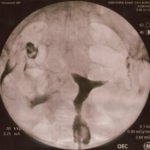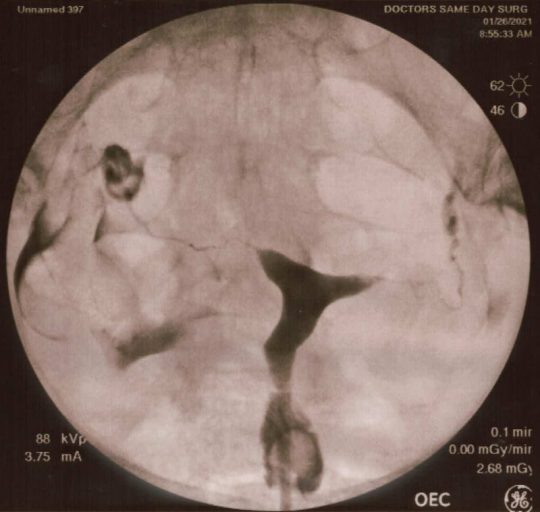
What is Hysterosalpingography (HSG)?
Hysterosalpingography (HSG) is a medical procedure used to evaluate the health of a woman’s reproductive system.
It involves the use of X-rays and contrast dye to create images of the uterus and fallopian tubes.
The HSG is the “gold standard” non-surgical method of evaluating the shape of the inside of the Uterus (womb) and whether the fallopian tubes are open with normal spill of the contrast dye out of the ends of the fallopian tubes.

Why and when is HSG performed?
HSG may be recommended if you are experiencing infertility, recurrent miscarriages, or unexplained pelvic pain. It may also be recommended before certain fertility treatments or surgeries.
HSG is typically performed early in the menstrual cycle, ideally between days 6 and 10, to ensure that the uterus is not occupied by a fertilized egg.
What does Hysterosalpingography diagnose?
Hysterosalpingography (HSG) can help diagnose a range of reproductive health issues, including
- blocked fallopian tubes,
- uterine abnormalities, and
- scarring.
It can also provide information about the shape and size of the uterus and the patency (the condition of being open, expanded, or unobstructed) of the fallopian tubes.
How is an HSG test done by Dr. Pabon?
Dr. Pabon has a very gentle technique for performing the HSG that is similar to an artificial insemination.
With his primary technique, he does not insert a catheter or tube through the cervix and into the Uterus. He avoids this technique because inserting a balloon catheter can cause much discomfort. Instead, he places a small (2mm) tip only about 5mm into the cervix and allows the contrast fluid to travel the rest of the way up the cervix and into the uterus and tubes.
During the HSG procedure, you will be asked to lie on an exam table, a speculum is placed in the vagina, the cervix is cleansed with a betadine swab and then saline. Then the cannula (a very thin tube) is placed against the cervix to infuse the contrast and to enable taking the X-ray pictures.
With Dr. Pabon’s technique, the X-ray exposure is minimal as this test usually requires less than 8 seconds of fluoroscopy.
The procedure typically takes approximately 15 minutes to complete, but the actual HSG exam takes less than 5 minutes.
Does HSG test hurt? What to expect?
Some women may experience mild discomfort or cramping during the HSG procedure as the contrast dye is infused.
You should be able to resume normal activities immediately after the HSG procedure, but some women may experience
mild cramping or spotting afterward.
Patients are advised to take 600 to 800 mg of ibuprofen 2 hours before to prevent cramping. Tylenol is acceptable in case of an allergy to ibuprofen.
HSG Patient's Testimonial
So, I had the HSG procedure and was very nervous because I read on the internet it might be very painful.
But Dr Pabon kept me informed the whole time . There was some discomfort at the beginning but Dr. Pabon made sure to do everything in his power to make sure I was as comfortable as I could be.
Explained all the images that were taken in depth. My experience was nothing like the internet described it. Thank you To the nurses and Dr. Pabon for making it a comfortable experience.
–Abigail T., via Google
How should I prepare for HSG test?
Dr. Pabon recommends that a recent test for Chlamydia and Gonorrhea be documented as negative. You will also be prescribed a preventative antibiotic (usually Doxycycline). As mentioned above, ibuprofen or tylenol before help to reduce cramps.
What is the recovery time for hysterosalpingography?
You should be able to resume normal activities immediately after the HSG procedure,
but some women may experience mild cramping or spotting for a few days afterward. We recommend no sexual activity for 2 days after.
Do you accept patients from other cities or as referral from other doctors for HSG?
Yes, we do accept patients from all of Florida. Most commonly we are seeing patients from Tampa Bay, St. Petersburg, Bradenton, Sarasota, Ft. Myers, Cape Coral, and Naples.
We’ve been seeing patients from all over Florida on a regular basis because, reportedly, it’s hard to find a local doctor offering Hysterosalpingography test. It might seem surprising but true.
Most patients don’t mind a short drive:
– if you are in Tampa or Riverside, it would take an hour, hour fifteen to our Fertility Clinic office in Sarasota,
– if you live in the Naples area it may take an hour and a half.
Where do you perform the HSG procedures?
Dr. Pabon usually meets and examines the patient in his offices in Sarasota or Bonita Springs before the HSG.
The actual HSG is most commonly performed at Doctor’s Hospital Same Day Surgery Center in Sarasota.
Summary
In summary, HSG is a diagnostic test that can help identify potential causes of infertility. The procedure is safe and generally well-tolerated, but some women may experience mild discomfort.
If you have been recommended an HSG, we would be happy to help you complete this test in the most comfortable way.
External Links
doi.org
- Hysterosalpingography Versus Sonohysterography for Intrauterine Abnormalities – PMC
- Comparison of Four Different Pain Relief Methods during Hysterosalpingography: A Randomized Controlled Study
ncbi.nlm.nih.gov
pubmed.ncbi.nlm.nih.gov
- Hysterosalpingography findings of female partners of infertile couple attending fertility clinic at Lagos University Teaching Hospital – PubMed
- Modern assessment of the uterine cavity and fallopian tubes in the era of high-efficacy assisted reproductive technology – PubMed
acog.org
radiologyinfo.org
mayoclinic.org
healthwise.org

Your Next Step:
Get your consultation time
by clicking the button below
or by calling 941-342-1568.
